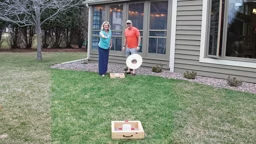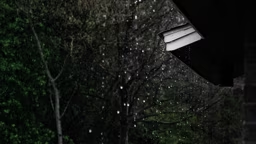I love cabin projects. I usually don’t even care who initiated the project. If it’s a good project, I don’t even mind if it was spawned by the “Honey Do List!”
My most recent project – like many before – grew over time and ended up a little over the top. Literally. You see, I love my hobbies and when you can attach a cabin project to a hobby … well it just doesn’t get any better than that.
A Hobby is Reborn
While on a photographic assignment at a remote resort, I was asked to photograph the Milky Way to illustrate how beautiful it was in this wilderness setting. The resulting digital image was really cool, and it renewed my interest in my past stargazing hobby. That, in turn, spawned my newest cabin project.
I realized I had stopped enjoying one of my favorite toys at the cabin: the telescope. For years, my telescope was part of a predictable pattern. Following a fun-filled day, great meal prepared on the grill and a beautiful sunset, we ventured down to the dock where the stars overhead would stop all of us in our tracks. They seemed bright enough to reach up and touch.
I had built a small platform next to the right hand corner of the dock; it was just big enough for the tripod. (It didn’t touch the regular sections, so there would be no vibration when others walked out on the dock.)
I’ll never forget finding and looking at the rings of Saturn for the first time; wow! I enjoyed looking at the moon and planets and even tried to find a few galaxies and nebulas. Back then, it was not easy, but I was hooked. The most difficult part those days was locating and keeping track of the object in the eyepiece.
My interest in stargazing waned when we moved to our new cabin. Our location up on a hill had an abundance of trees. My new dock section/walkway down at the lake was 198 feet long over a bog and wasn’t conducive to having a telescope on it. I just didn’t have a good spot from which to view the stars. My trusted telescope, which had given me hours of enjoyment before, now sat collecting dust.
My most recent project – like many before – grew over time and ended up a little over the top. Literally. You see, I love my hobbies and when you can attach a cabin project to a hobby … well it just doesn’t get any better than that.
A Hobby is Reborn
While on a photographic assignment at a remote resort, I was asked to photograph the Milky Way to illustrate how beautiful it was in this wilderness setting. The resulting digital image was really cool, and it renewed my interest in my past stargazing hobby. That, in turn, spawned my newest cabin project.
I realized I had stopped enjoying one of my favorite toys at the cabin: the telescope. For years, my telescope was part of a predictable pattern. Following a fun-filled day, great meal prepared on the grill and a beautiful sunset, we ventured down to the dock where the stars overhead would stop all of us in our tracks. They seemed bright enough to reach up and touch.
I had built a small platform next to the right hand corner of the dock; it was just big enough for the tripod. (It didn’t touch the regular sections, so there would be no vibration when others walked out on the dock.)
I’ll never forget finding and looking at the rings of Saturn for the first time; wow! I enjoyed looking at the moon and planets and even tried to find a few galaxies and nebulas. Back then, it was not easy, but I was hooked. The most difficult part those days was locating and keeping track of the object in the eyepiece.
My interest in stargazing waned when we moved to our new cabin. Our location up on a hill had an abundance of trees. My new dock section/walkway down at the lake was 198 feet long over a bog and wasn’t conducive to having a telescope on it. I just didn’t have a good spot from which to view the stars. My trusted telescope, which had given me hours of enjoyment before, now sat collecting dust.
A Building Project to Support a Hobby
After shooting the night sky for the resort assignment, that stargazing passion was rekindled. So I started researching new telescopes and the new technology and computerization then purchased a new telescope.
However, one thing leads to another. It was obvious that my bigger and better telescope would require a bigger and better viewing station – and one that would clear the trees.
Here was the challenge of my new project: I needed to build a high platform that would stand free from my existing 198-foot dock/walkway. It needed to be stable, so I had to pound pylons into the bog. It took 18 pylons. I then built a solid 5x6-foot treated framework to support an 8x10-foot platform on top of the pylons – all of it sitting next to my existing dock and walkway. In my area, we have brush that grows up around 6 to 7 feet tall. So I built 6 feet higher, atop sturdy treated beams, so the platform would sit above the brush. I built a set of stairs up one side that did not attach to the existing dock but was easily accessible to it.
The end result was a sturdy platform; a permanent location for my new larger telescope to enjoy my old/new hobby. (See photo of platform on next page.)
New Technology, Better Stargazing
Thanks to my new telescope, gone were the days of struggling with sky maps, searching for and learning constellations and stars and trying to track and stay with those night objects.
Now you can get GoTo technology and built-in Global Positioning System (GPS) technology. These tell the telescope your location and the time of day, so your telescope knows where you are in relationship to 6,000-plus stars and what cool celestial stuff is available for you to view.
Many low-priced telescopes, starting at about $300, not only offer GoTo technology but also have extensive databases built into the computer-tracking capability. You align to the sky using an easy-to-follow keypad, select bright stars that you don’t even have to know or name, then your telescope – knowing your location – automatically skews or tracks over to the object you want to see. You can then fine-tune it with your eyepiece and even change eyepieces to adjust the magnification to suit your preference.
The best thing: The new scopes track and stay on the object allowing it to be viewed for a long period of time. You can walk away from the scope while friends and family take turns looking at your discovery, perhaps a mind-blowing celestial treat like the rings of Saturn or Jupiter’s storm spot. You can try to count how many moons are circling Saturn. Did you know astronomers – many of them amateurs – have found over fifty moons around Saturn?
Taking technology to another level, you can load your laptop with star-finding software. One computer program will take you to all the Apollo moon-landing sites. You can actually take your laptop out on your deck or dock and use a program to help you find where Neil Armstrong first stepped on the moon!
Finding these types of sites in the cosmos is easy, or better put, a heck of a lot easier than when I bought my first telescope (back when the dinosaurs roamed).
Expectations
A note of caution: Magazines and Web sites show beautiful full-color photographs of planets, galaxies and nebulas. With GoTo technology, you can easily go to these same objects and see them with your own eyes.
These celestial wonders are breathtaking to view through a telescope and well worth the time and patience it may take you to find them. But they won’t look quite like the incredible color photographs you see in the magazines and books. Those photos were taken with the Hubble telescope and with special color wheels and filters to bring out detail, color and subtlety that you won’t see with your naked eye.
Nonetheless, the cabin is the ideal place to enjoy and share the wonders of our universe. And you will spark very interesting conversations with family and friends. And why not??The cabin is also a great place for philosophical discussions and debates about life’s mysteries. I’ve discovered that my telescope prompts more questions than it answers!
A recent ad for telescopes shows vacationers saying that the coolest thing they saw while visiting Mexico was Saturn. Similarly, visitors to our cabin have said, “I learned to water-ski this weekend and saw the rings of Saturn!”
Low Tech is Fun Too
Stargazing can be fun even if you don’t buy a telescope or computer program. Next time you’re headed to the cabin, just pick up a current issue of “Sky & Telescope” magazine or “Astronomy” magazine. You’ll find a pull out map that shows all the cool stuff to look at that month. For your flashlight, pick up a red gel sheet, available at professional camera shops or theatrical supply stores. (Red light doesn’t interfere with night vision.)
During a clear night at the cabin, head out on your deck or dock. With the red glow of the flashlight and your easy-to-read charts, you’ll be identifying constellations and stars in no time.
You can also use an existing pair of binoculars to look a little closer if you want. Good binoculars made for astronomy are not expensive and are a preferred way of enjoying the cosmos for thousands of fun-seeking amateurs. With the plain eye, you can spot about 6,000 stars. With a pair of binoculars you can spot one million! “Astronomy” magazine can assist you further with their monthly column, “Phil Harrington’s Binocular Universe,” dedicated to observing this month’s cool stuff with binoculars.
Steve Umland says his stargazing hobby is a gift that’s enabled him:
To look up and stop.
To contemplate.
To give thanks.
To say things without saying anything.
To make a commitment to see and learn more.
To be asked important questions by hungry minds that he is responsible for.
To have one more reason to love every precious moment at the cabin.
After shooting the night sky for the resort assignment, that stargazing passion was rekindled. So I started researching new telescopes and the new technology and computerization then purchased a new telescope.
However, one thing leads to another. It was obvious that my bigger and better telescope would require a bigger and better viewing station – and one that would clear the trees.
Here was the challenge of my new project: I needed to build a high platform that would stand free from my existing 198-foot dock/walkway. It needed to be stable, so I had to pound pylons into the bog. It took 18 pylons. I then built a solid 5x6-foot treated framework to support an 8x10-foot platform on top of the pylons – all of it sitting next to my existing dock and walkway. In my area, we have brush that grows up around 6 to 7 feet tall. So I built 6 feet higher, atop sturdy treated beams, so the platform would sit above the brush. I built a set of stairs up one side that did not attach to the existing dock but was easily accessible to it.
The end result was a sturdy platform; a permanent location for my new larger telescope to enjoy my old/new hobby. (See photo of platform on next page.)
New Technology, Better Stargazing
Thanks to my new telescope, gone were the days of struggling with sky maps, searching for and learning constellations and stars and trying to track and stay with those night objects.
Now you can get GoTo technology and built-in Global Positioning System (GPS) technology. These tell the telescope your location and the time of day, so your telescope knows where you are in relationship to 6,000-plus stars and what cool celestial stuff is available for you to view.
Many low-priced telescopes, starting at about $300, not only offer GoTo technology but also have extensive databases built into the computer-tracking capability. You align to the sky using an easy-to-follow keypad, select bright stars that you don’t even have to know or name, then your telescope – knowing your location – automatically skews or tracks over to the object you want to see. You can then fine-tune it with your eyepiece and even change eyepieces to adjust the magnification to suit your preference.
The best thing: The new scopes track and stay on the object allowing it to be viewed for a long period of time. You can walk away from the scope while friends and family take turns looking at your discovery, perhaps a mind-blowing celestial treat like the rings of Saturn or Jupiter’s storm spot. You can try to count how many moons are circling Saturn. Did you know astronomers – many of them amateurs – have found over fifty moons around Saturn?
Taking technology to another level, you can load your laptop with star-finding software. One computer program will take you to all the Apollo moon-landing sites. You can actually take your laptop out on your deck or dock and use a program to help you find where Neil Armstrong first stepped on the moon!
Finding these types of sites in the cosmos is easy, or better put, a heck of a lot easier than when I bought my first telescope (back when the dinosaurs roamed).
Expectations
A note of caution: Magazines and Web sites show beautiful full-color photographs of planets, galaxies and nebulas. With GoTo technology, you can easily go to these same objects and see them with your own eyes.
These celestial wonders are breathtaking to view through a telescope and well worth the time and patience it may take you to find them. But they won’t look quite like the incredible color photographs you see in the magazines and books. Those photos were taken with the Hubble telescope and with special color wheels and filters to bring out detail, color and subtlety that you won’t see with your naked eye.
Nonetheless, the cabin is the ideal place to enjoy and share the wonders of our universe. And you will spark very interesting conversations with family and friends. And why not??The cabin is also a great place for philosophical discussions and debates about life’s mysteries. I’ve discovered that my telescope prompts more questions than it answers!
A recent ad for telescopes shows vacationers saying that the coolest thing they saw while visiting Mexico was Saturn. Similarly, visitors to our cabin have said, “I learned to water-ski this weekend and saw the rings of Saturn!”
Low Tech is Fun Too
Stargazing can be fun even if you don’t buy a telescope or computer program. Next time you’re headed to the cabin, just pick up a current issue of “Sky & Telescope” magazine or “Astronomy” magazine. You’ll find a pull out map that shows all the cool stuff to look at that month. For your flashlight, pick up a red gel sheet, available at professional camera shops or theatrical supply stores. (Red light doesn’t interfere with night vision.)
During a clear night at the cabin, head out on your deck or dock. With the red glow of the flashlight and your easy-to-read charts, you’ll be identifying constellations and stars in no time.
You can also use an existing pair of binoculars to look a little closer if you want. Good binoculars made for astronomy are not expensive and are a preferred way of enjoying the cosmos for thousands of fun-seeking amateurs. With the plain eye, you can spot about 6,000 stars. With a pair of binoculars you can spot one million! “Astronomy” magazine can assist you further with their monthly column, “Phil Harrington’s Binocular Universe,” dedicated to observing this month’s cool stuff with binoculars.
Steve Umland says his stargazing hobby is a gift that’s enabled him:
To look up and stop.
To contemplate.
To give thanks.
To say things without saying anything.
To make a commitment to see and learn more.
To be asked important questions by hungry minds that he is responsible for.
To have one more reason to love every precious moment at the cabin.
 Steve Umland
Steve Umland 










